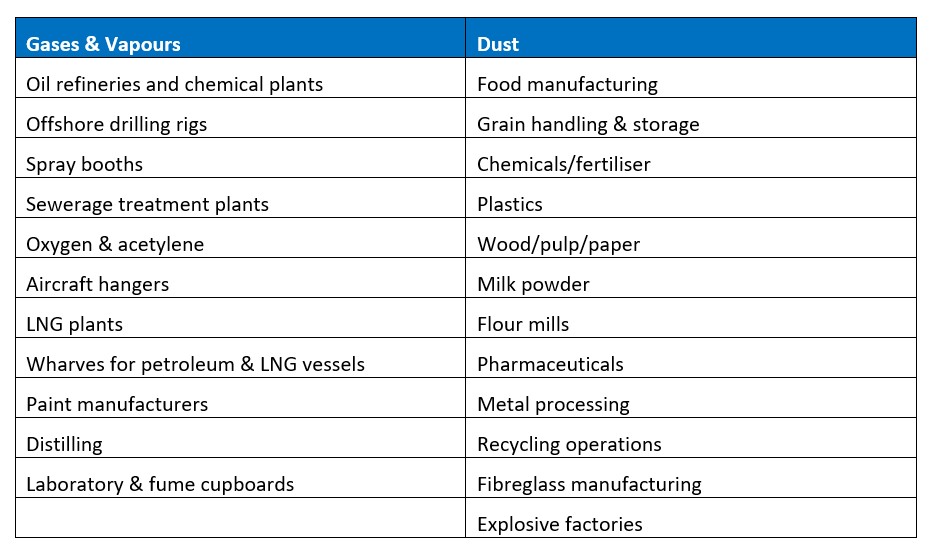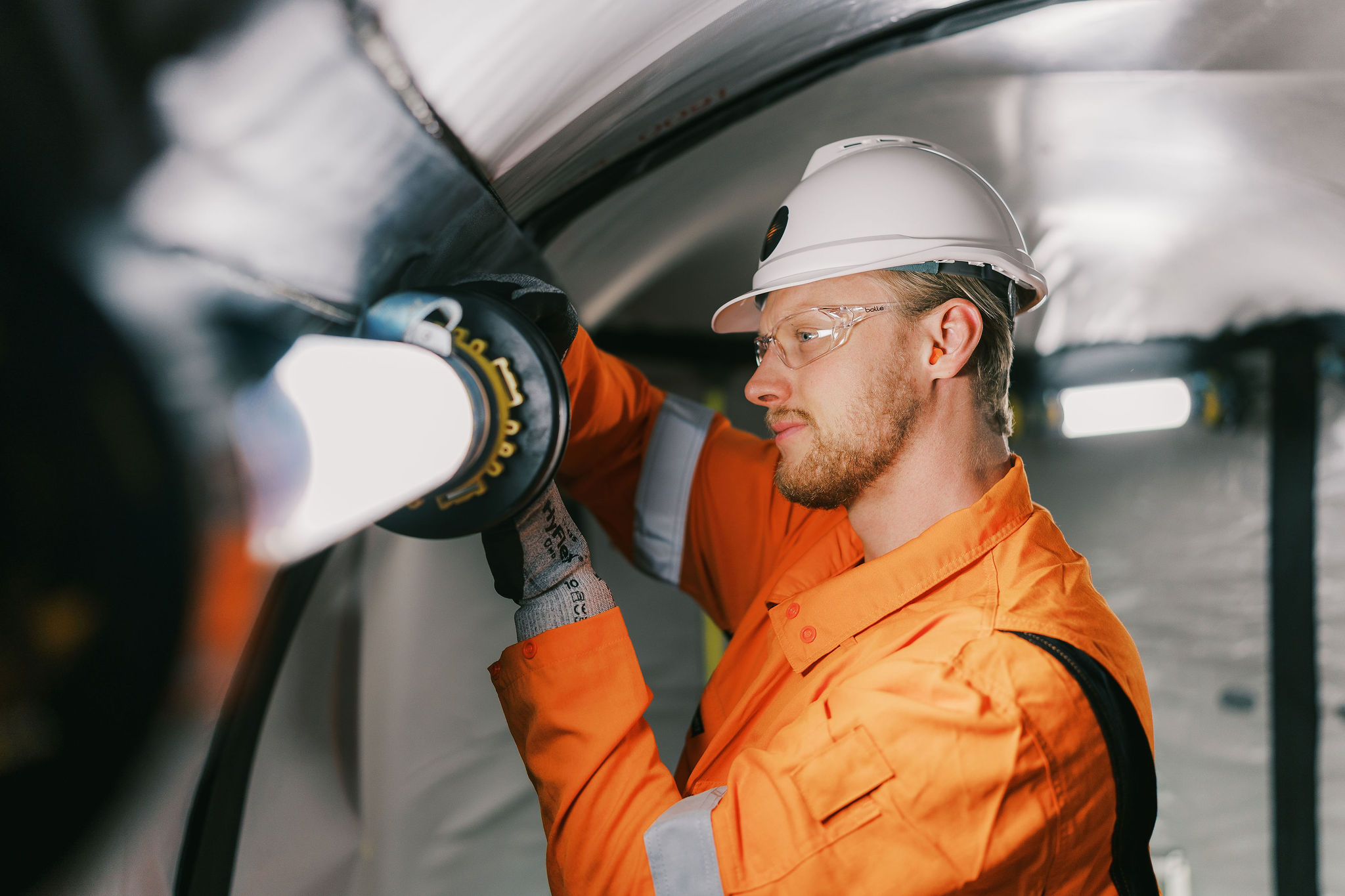The 10-Second Trick For Roar Solutions
The 10-Second Trick For Roar Solutions
Blog Article
Some Known Incorrect Statements About Roar Solutions
Table of ContentsFascination About Roar SolutionsRoar Solutions Can Be Fun For AnyoneEverything about Roar Solutions
In such an atmosphere a fire or surge is possible when three standard conditions are fulfilled. This is commonly referred to as the "unsafe location" or "combustion" triangular. In order to secure setups from a possible explosion a method of analysing and classifying a potentially harmful area is called for. The function of this is to guarantee the proper selection and installment of devices to inevitably protect against an explosion and to make sure security of life.
(https://my.omsystem.com/members/roarsolutions)
No equipment needs to be installed where the surface area temperature level of the equipment is more than the ignition temperature of the given risk. Below are some common dust dangerous and their minimum ignition temperature level. Coal Dust 380C 225C Polythene 420C (melts) Methyl Cellulose 420C 320C Starch 460C 435C Flour 490C 340C Sugar 490C 460C Grain Dirt 510C 300C Phenolic Material 530C > 450C Aluminium 590C > 450C PVC 700C > 450C Residue 810C 570C The probability of the danger existing in a concentration high enough to trigger an ignition will vary from area to place.
In order to identify this risk an installment is separated into locations of threat relying on the quantity of time the dangerous is existing. These locations are referred to as Areas. For gases and vapours and dirts and fibres there are 3 zones. Area 0 Zone 20 An unsafe ambience is extremely likely to be existing and may exist for lengthy durations of time (> 1000 hours each year) or also continuously Zone 1 Zone 21 A dangerous ambience is possible yet unlikely to be existing for extended periods of time (> 10 450 C [842 F] A classification of T6 implies the minimum ignition temperature is > 85 C [185 F] Unsafe location electric equipment possibly designed for usage in higher ambient temperature levels. This would indicated on the ranking plate e.g. EExe II C T3 Ta + 60C( This implies at 60C ambient T3 will certainly not be surpassed) T1 T1, T2, T3, T4, T5, T6 T2 T2, T3, T4, T5, T6 T3 T3, T4, T5, T6 T4 T4, T5, T6 T5 T5, T6 T6 T6 A T Course rating of T1 means the optimum surface area temperature level generated by the instrument at 40 C is 450 C. Assuming the associated T Class and Temperature rating for the devices are ideal for the location, you can constantly use an instrument with a much more rigorous Division score than needed for the area. There isn't a clear solution to this inquiry regrettably. It actually does depend on the sort of equipment and what repair services need to be performed. Tools with certain test procedures that can't be done in the field in order to achieve/maintain 3rd party score. Need to return to the factory if it is prior to the equipment's service. Field Repair Work By Authorised Worker: Difficult screening might not be required nevertheless details treatments might require to be complied with in order for the devices to preserve its third event rating. Authorised personnel should be utilized to perform the work correctly Fixing must be a like for like substitute. New part should be taken into consideration as a straight substitute calling for no unique screening of the devices after the repair is complete. Each tool with an unsafe rating ought to be evaluated independently. These are described at a high level listed below, but also for even more in-depth information, please refer directly to the standards.
How Roar Solutions can Save You Time, Stress, and Money.
The equipment register is an extensive data source of equipment documents that includes a minimum set of fields to identify each product's area, technological criteria, Ex category, age, and ecological information. This information is essential for tracking and handling the equipment efficiently within harmful areas. On the other hand, for periodic or RBI sampling evaluations, the quality will certainly be a mix of Detailed and Close evaluations. The ratio of Comprehensive to Shut examinations will certainly be established by the Equipment Risk, which is assessed based on ignition risk (the probability of a source of ignition versus the probability of a combustible atmosphere )and the hazardous location classification
( Zone 0, 1, or 2). This variation will likewise influence the resourcing demands for work preparation. Once Whole lots are specified, you can establish tasting strategies based on the sample size of each Whole lot, which describes the variety of arbitrary equipment products to be inspected. To figure out the called for example size, two aspects require to be examined: the size of the Lot and the group of examination, which shows the degree of effort that ought to be applied( lowered, typical, or enhanced )to the evaluation of the Whole lot. By integrating the category of inspection with the Great deal dimension, you can then establish the proper denial requirements for an example, suggesting the permitted number of malfunctioning products found within that sample. For even more details on this procedure, please refer to the Power Institute Standards. The IEC 60079 standard suggests that the maximum interval between evaluations need to not exceed three years. EEHA examinations will likewise be conducted outside of RBI campaigns as component of set up maintenance and devices overhauls or repairs. These assessments can be attributed toward the RBI sample sizes within the influenced Lots. EEHA inspections are conducted to determine faults in electric equipment. A weighted racking up system is crucial, as a solitary piece of devices might have numerous mistakes, each with differing degrees of ignition risk. If the combined score of both assessments is less than twice the fault rating, the Lot is deemed acceptable. If the Great deal is still taken into consideration unacceptable, it should undertake a full assessment or reason, which may set off stricter assessment methods. Accepted Whole lot: The reasons of any type of mistakes are determined. If an usual failing mode is found, extra equipment might need examination and repair. Faults are categorized by seriousness( Security, Honesty, Housekeeping ), ensuring that urgent issues are assessed and attended to without delay to alleviate any type of influence on security or operations. The EEHA database ought to track and record the lifecycle of mistakes in addition to the rehabilitative actions taken. Executing a robust Risk-Based Examination( RBI )method is crucial for ensuring compliance and security in taking care of Electric Devices in Hazardous Locations( EEHA) (eeha training). Automated Fault Rating and Lifecycle Management: Effortlessly handle mistakes and track their lifecycle to improve evaluation precision. The introduction of this assistance for risk-based inspection additionally strengthens Inspectivity's placement as a best-in-class option for regulative compliance, as well as for any type of asset-centric evaluation usage case. If you want discovering extra, we welcome you to ask for a demonstration and uncover how our remedy can transform your EEHA administration procedures.
The 8-Minute Rule for Roar Solutions

In regards to eruptive risk, a hazardous location is an atmosphere in which an eruptive environment exists (or might be expected to be existing) in quantities that require unique precautions for the construction, setup and use of equipment. electrical refresher course. In this write-up we discover the challenges dealt with in the work environment, the risk control procedures, and the needed competencies to work securely
It issues of modern-day life that we make, keep or take care of a series of gases or liquids that are deemed combustible, and a variety of dirts that are deemed flammable. These substances can, in specific conditions, form explosive atmospheres and these can have significant and unfortunate consequences. The majority of us know with the fire triangle eliminate any one of the three components and the fire can not occur, yet what does this mean in the context of unsafe areas? When breaking this down into its most basic terms visit the site it is essentially: a combination of a certain amount of release or leak of a particular material or product, blending with ambient oxygen, and the presence of a source of ignition.
In most circumstances, we can do little about the levels of oxygen in the air, however we can have substantial impact on sources of ignition, as an example electrical devices. Hazardous locations are recorded on the unsafe location category illustration and are determined on-site by the triangular "EX LOVER" indication. Here, amongst other essential information, zones are split right into 3 kinds relying on the danger, the probability and period that an eruptive atmosphere will exist; Zone 0 or 20 is regarded the most dangerous and Zone 2 or 22 is regarded the least.
Report this page